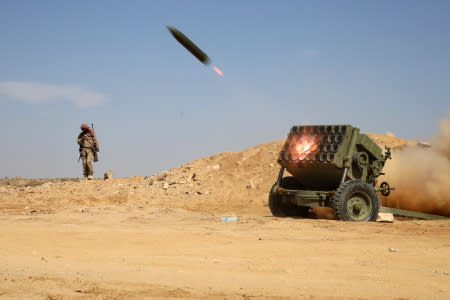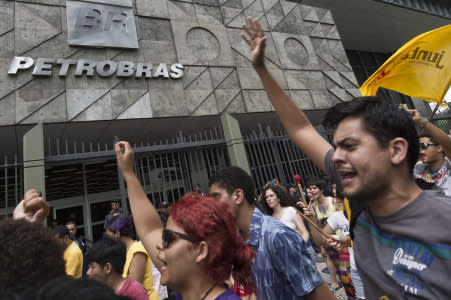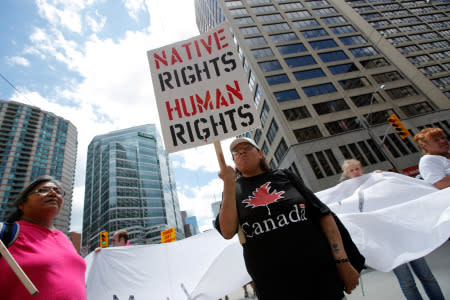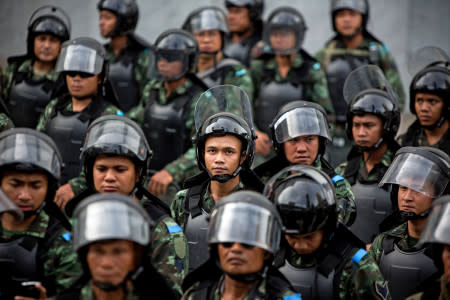Stories You Missed in 2015
Colombia (slowly) neared the end of its long war
It’s one of the world’s longest-running conflicts: Colombia’s war against the FARC, the leftist guerrilla faction, has dragged on for more than 50 years and has left 220,000 dead while displacing millions. In 2015, however, negotiations to end the long war made significant progress, and a final peace deal is now expected to be signed as early as this coming spring, though the original March 23 target is unlikely to be met.
The formal peace process — which began between FARC and government negotiators in Havana, Cuba, in November 2012 — has dragged on for years, mired by failed ceasefires; threats from both sides to walk away; public skepticism; and spoilers, such as former President Álvaro Uribe, who have tried to derail the process. The central sticking points for negotiators — and for garnering the support of the Colombian public — have been the questions of who should be punished, and how, for the years of war, and how rebel combatants can be reincorporated into Colombian society after spending decades in the bush.
So what actually happened in 2015? Well, a lot. Perhaps most significantly, despite repeated bursts of violence — FARC forces bombed oil pipelines and killed soldiers in ambushes, and government forces bombed FARC camps — neither side walked away from the Havana-mediated talks, a clear indication that leaders are serious about putting the conflict to bed. The FARC agreed to end its participation in the drug trade and its recruitment of child soldiers, and the government agreed to end its bombing of guerilla camps. They agreed to work together to clear landmines. In July, the FARC began a unilateral ceasefire — a huge step forward in the peace process. In September, terms were reached on amnesty for lower-level fighters and punishment for rebel leaders and military officers who had committed war crimes and crimes against humanity — a major breakthrough. In December, Colombia for the first time declined to extradite a rebel fighter wanted for drug trafficking to the United States — a sign of the government’s commitment to maintain positive relations with the rebel group.
“I believe that ending a 50-year war isn’t going to be simple; surely there will be problems,” Iván Cepeda, a left-wing senator and vocal supporter of the peace process, said this fall. “But the general tendency is that we are taking steps, each time more seriously, towards peace.”
Fighting continued in forgotten Yemen
Yemen began 2015 on the edge of civil war. Conflict between the Shiite rebel Houthis and the government, which had been building a new power-sharing deal that threatened Houthi power, came to a head in January when the rebels forced President Abd Rabbuh Mansur Hadi to resign and announced plans to dissolve parliament. In March, when Saudi Arabia intervened at the behest of Hadi, the country tipped into outright war. A Saudi-led coalition comprised of Bahrain, Egypt, Jordan, Kuwait, Morocco, Sudan, the United Arab Emirates, and Qatar began bombing Houthi positions, and brought the war to the civilian population.
According to the United Nations, fighting has killed nearly 6,000 people since the Saudi-led bombing campaign began in March — with a heavy civilian toll — and roughly 80 percent of the country’s population, or 21 million people, requires some kind of humanitarian assistance. “Half of the country [is] now just one step away from famine,” Matthew Hollingworth, the World Food Program’s deputy regional director, said in December.
While some 2.3 million people have been displaced internally, more than 120,000 people have left the country since April, risking their lives getting out of Yemen, fleeing to countries that can hardly be counted as safe havens. “I hear first-hand accounts of it whenever I speak with women, children, and elderly people who have made the perilous crossing to reach Djibouti, Ethiopia, and Somalia,” Claire Bourgeois, UNHCR’s regional refugee coordinator for Yemen, said recently.
With larger conflicts upending Syria and Iraq, the unraveling of Yemen has received less than top billing in media coverage of the Middle East. But because Yemen is adjacent to a vital chokepoint for oil shipping at the opening of the Red Sea, the war could have severe consequences for global oil markets. Observers have noted, too, that Saudi Arabia’s aggressive involvement can be read as an escalation of its rivalry with Iran, and one that opens the door to a possible confrontation between the two regional powers. The growth of the Islamic State’s influence in the country — and the persistence of al Qaeda in the Arabian Peninsula — is worrying, too, as the destabilized country has become a safe haven from extremists who might use it as a base for attacks abroad.
Peace talks brokered by the United Nations that began in December initially promised real progress toward ending the fighting, but any hope for a deal quickly fell apart as new fighting shattered the latest ceasefire. Talks between the Hadi government and the Houthi rebels are slated to resume in mid-January.
China and Japan’s cold war got hotter
It’d be right to assume that a cold war in the making between two of the world’s top economic powers would be big news. But Western media had relatively little to say about how Beijing and Tokyo (with the help of the United States) were each forging alliances around Asia to counter the other country.
While tensions have continued to smolder between China, the world’s second-largest economy, and its erstwhile enemy — the world’s third-largest economy, Japan — both countries have embarked on diplomatic charm offensives across the region. Beijing has given sweetheart deals to Nepal, Cambodia, and Pakistan, and has mollified North Korea, while Japanese Prime Minister Shinzo Abe has solidified his bromance with Indian Prime Minister Narendra Modi and has improved Japan’s defense ties with nations with claims in the South China Sea — claims that overlap with Beijing’s.
Though Beijing’s cold tensions with Tokyo could turn hot, that they remain lukewarm is the reason they’ve been mostly overlooked. The news-consuming populace paid much more attention in 2015 to China’s aggressive moves in the South China Sea, where its successful land reclamation projects on disputed islands and reefs have drawn condemnation from Washington and Southeast Asian nations. And yet, the tensions over the disputed islands in the East China Sea — which the Japanese, who administer them, call the Senkaku, and the Chinese, who claim them, call the Diaoyu — could prove far more explosive, and not just because the United States is treaty-bound to defend Japan.
While things seem to have calmed down in the last few months, both sides are holding their ground. In December, Reuters reported that Japan is building up anti-ship, anti-aircraft missile batteries on a string of East China Sea islands. The purpose, according to the Japanese officials in the article? To keep China at bay.
Brazil’s state-owned oil company scandal got messier
In 2015, Brazil’s most powerful political and business leaders struggled to recover from revelations surrounding the massive bribery scandal involving Petrobras, the country’s state-owned oil company. Under the kickback scheme, first uncovered in 2014, some of Petrobras’s executives took massive bribes from a bloc of construction and services companies in exchange for contracts. They also sent some of that money to top members of Brazil’s ruling left-leaning Workers’ Party (PT). According to investigators, the PT took some $200 million in kickbacks, largely to spend on political campaigns. Petrobras itself puts the total amount of all bribes at around $3 billion.
Throughout 2015, the fallout from the scandal led to mass protests and political turmoil for President Dilma Rousseff, who served as chairwoman of Petrobras (though she has not been charged). She faces potential impeachment proceedings over her handling of the country’s $27 billion budget gap, and according to a recent poll, two out of three Brazilians think she should resign. Meanwhile, top leaders of the PT and of Brazil’s major businesses continue to be arrested as part of the investigation into the scandal, as Brazil sinks further into recession.
While the scandal surrounding Petrobras was revealed in 2014, the events of 2015 showed the world how political instability can arise from massive financial economic impropriety, even in a country once heralded for its economic growth and future promise. No doubt, new details of the corruption scandal will emerge in 2016, as more politicians and business leaders are ensnared, and as Rousseff’s government struggles to hold on for dear life as restive Brazilians demand change. The shine has come off for Brazil, which was posited as recently as 2010 to be one of the world’s leading emerging economies. “I’ve never seen my countrymen so angry,” a political science professor at Rio de Janeiro State University told the New York Times. “We have this sense that the dream is over.”
Canada reckoned with the fate of its missing women
Over the past 30 years, some 1,200 indigenous Canadian women and girls have disappeared or been killed. Along Highway 16 in British Colombia alone, some 18 women are known to have gone missing since the 1960s — a number that Amnesty International says may actually be much higher. The 435-mile-long route, which winds its way through remote indigenous communities, has come to be known as the “Highway of Tears.”
While Amnesty International calls the situation “a national human rights crisis,” the Canadian government has largely avoided the issue, ever since it began in the 1970s with a push for indigenous people to move to cities. Hundreds of current cases remain unsolved. “It’s not really high on our radar, to be honest,” former Prime Minister Stephen Harper said of the epidemic of violence. According to a report by Canada’s national statistics agency, indigenous women are six times more likely to be murdered than other Canadians and are far likelier than non-indigenous women to be murdered outside the home. Indigenous men and women both face an elevated risk of violence.
At the end of 2015, the attitude of the Canadian government began to change. On Dec. 8, new Prime Minister Justin Trudeau announced that he would embark on a long-overdue national inquiry into the disappearances and murders — a step the U.N. called for in March. And on Nov. 12, the government nominally endorsed the United Nations Declaration on the Rights of Indigenous Peoples. The declaration, which sets out a number of individual and collective rights and state obligations, is not legally binding but could signify a cultural shift on the part of the Trudeau administration.
For decades, this year included, the plight of Canada’s indigenous women didn’t receive proportionate attention, especially outside Canada. That could start to change, now that Trudeau seems committed to keeping the issue front and center.
And while these efforts to find the truth and seek justice are underway, the question remains: What can Canada do moving forward to achieve real change? Dozens of studies have revealed the extent of the problem over the years, but it has persisted nonetheless. Trudeau’s election was itself the Canada story of the year for international readers — the plight of Canada’s indigenous women still remains largely unknown. Now that the issue is finally gaining mainstream traction, the government will have to fight an uphill battle to prove its efforts are anything but too little, too late.
Ireland got back in business
By 2013, Ireland had begun to recover from a crushing financial slump that led to a three-year rescue effort by international lenders to save the country from bankruptcy. Finance Minister Michael Noonan said that the crisis was the worst his country had seen since the potato famine, which began in 1845. Few then could have predicted that Ireland’s economy would surge ahead of those of its eurozone neighbors by the end of 2015. But that’s just what happened.
In the first half of 2015, Ireland’s GDP grew 7 percent year-on-year, returning the economy to pre-crisis levels. And the recovery’s not yet done. Unemployment fell from 15.2 percent in 2012 to 8.9 percent in October, but that rate could continue to drop and the economy still has plenty of room to improve in the coming year. According to a recent survey, 97 percent of Irish employers plan to raise wages in 2016, and the European Commission forecasts strong growth at least through 2017.
In 2015, the Irish economy grew faster than that of any other developed country, surpassing China and the rest of the EU — a story overshadowed in European economic news this years by tales of woe, from the Greek bailout to slowdowns across the region. While Ireland may be a unique example, helped by unusually high exports and other mitigating conditions, it could serve nonetheless as a glimmer of hope for post-recovery Europe.
That is, unless Britain leaves the EU, which would be a major setback for the Irish economy. “We all expect and want the United Kingdom to stay,” EU economics commissioner Pierre Moscovici said. All European Commission forecasts are premised on the U.K. remaining in place. But it might not: Britain is committed to holding a referendum on the matter, and a split could impact Irish trade, foreign direct investment, migration, and the energy sector.
Thailand saw a human rights breakdown
On Dec. 14, Thai authorities filed criminal indictments against a 27-year-old factory worker named Thanakorn Siripaiboon. Charged under section 112 of the Penal Code, Thanakorn stood accused of lèse majesté — insulting the king. The charge itself was not particularly notable. Thailand’s rulers have long used lèse majesté to silence opponents of the crown; since May 2014 alone, at least 56 cases have been filed. Yet Thanakorn’s case added a new dimension of absurdity: The young man is being prosecuted in a military court for allegedly posting “sarcastic” remarks on Facebook about the aging monarch’s dog (the specific insults, such as they were, have not been made public). For the wanton defamation of a mutt, Thanakorn faces 37 years in prison.
The case highlights the slow deterioration of rights under the ruling military government, which took control of the country in a coup in May 2014. Since taking power, the junta, led by Prime Minister Gen. Prayuth Chan-ocha, has squashed any perceived opposition to the government, detaining intellectuals and activists, blocking critical websites, and even banning public gatherings of more than five people.
This downward spiral has only continued in 2015. In March, Prayuth warned journalists against negative reporting, saying he would “probably just execute” those who did “not report the truth.” And the crackdown extends beyond locals who are perceived to be dissidents: In December, the government began investigating none other than the U.S. ambassador for allegedly insulting the king during public comments criticizing the junta’s rights record. Meanwhile, as the generals trawl Facebook for allied diplomats and dissident factory workers, the Thai economy is cratering. But it isn’t just that Thailand is suffering internally from this crackdown — its relationship with the United States has clearly frayed, too. Though the country was once a bright spot in the region, and America’s top partner, Thailand’s star is falling, and no amount of arrests will change that.
Photo credits: Charles Lomodong/AFP/Getty Images; Pedro Ugarte/AFP/Getty Images; Abdullah al-Qadry/AFP/Getty Images; Kazuhiro Nogi/AFP/Getty Images; Vanderlei Almeida/AFP/Getty Images; Jemal Countess/Getty Images; Peter Macdiarmid/Getty Images








